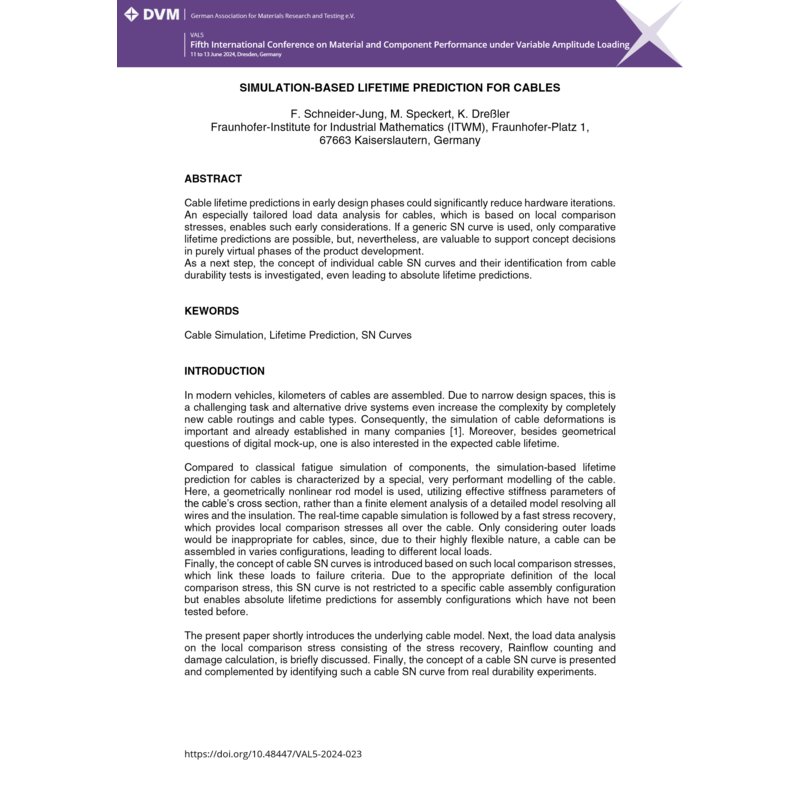- Online only



In modern vehicles, the routing of cables is complex due to narrow design spaces. With alternative drive systems, new components come into the vehicle, often accompanied by new cable routings or completely new cable types. Therefore, there is a lack of experience with those new routings or cables.
In many companies, the simulation of cables with geometrically exact rod models is already well established. Thus, already in the design phase, possible conflicts can be solved. Typical questions are related to the expected cable deformations, the optimal length of the cable, or required mounting positions. Also, one tries to find cable routings which reduce (static and variable) loads in the cable as well as reaction forces and moments at the mounting points.
In this work, we…

Datenschutzbedingungen (bearbeiten im Modul "Kundenvorteile")

Lieferbedingungen (bearbeiten im Modul "Kundenvorteile")

Rücksendebedingungen (bearbeiten im Modul "Kundenvorteile")
In modern vehicles, the routing of cables is complex due to narrow design spaces. With alternative drive systems, new components come into the vehicle, often accompanied by new cable routings or completely new cable types. Therefore, there is a lack of experience with those new routings or cables.
In many companies, the simulation of cables with geometrically exact rod models is already well established. Thus, already in the design phase, possible conflicts can be solved. Typical questions are related to the expected cable deformations, the optimal length of the cable, or required mounting positions. Also, one tries to find cable routings which reduce (static and variable) loads in the cable as well as reaction forces and moments at the mounting points.
In this work, we want to present and discuss an approach to simulation-based lifetime prediction for cables. Two aspects are considered: (1) the definition of a suitable local load to count load cycles and (2) identifying an SN curve from cable lifetime tests based on this local load, which can be used for damage calculation.
Usually, due to its flexible nature, a cable has no unique installation position and local deformations are not known a priori. Thus, obviously, we need to look at local loads along the cable rather than external loads at the boundaries.
From the simulation, we get forces and moments (i.e., cross-section-integrated quantities) at arbitrary arc length positions. Those are mapped to local stress quantities at the surface of the cable, which shall be used for Rainflow counting and SN curve identification. Well-known candidates are, e.g., local stresses generated via the critical plane approach or local forces pointing in characteristic directions.
Once the local load signals are computed, it is straight forward to apply Rainflow counting to each signal to find triples of load amplitude, mean load and number of load cycles.
Finally, a damage calculation can be performed. With a generic SN curve, only a comparative analysis is possible. To achieve absolute damage calculations, a specific SN curve is required, which represents the correct fatigue behavior of the cable of interest.
Recently, we studied the concept of a cable SN curve. Obviously, such a cable SN curve only is valuable if it is independent of the cable installation, i.e., independent of the cable length, its routing or its mounting position and orientation. Thus, on the one hand, as already mentioned, the suitable definition of the local load is essential. Only if this is appropriate, we have a chance to find the desired cable SN curve. On the other hand, several tests with different local deformations must be considered to establish a sufficient database covering the most important local stress states, which cause the fatigue failure.
The interesting question is, if – by the appropriate selection of the local stress quantity – a common SN curve can be found for the fatigue data from all tests. This idea has some similarities with the well-known RxMS approach for establishing SN curves for welding points.
In the real tests, we observe a possible failure by monitoring the electrical resistance. But measuring local loads along the cable during the experiment is very difficult or simply impossible. Therefore, we also simulate the tests to virtually measure the local loads. The collected fatigue data, from both the real and the virtual test, is utilized in a maximum likelihood method and provides the desired SN curve for the considered cable.
For a first cable type, lifetime experiments with several different installations have been performed and an SN curve could be identified, which fits to the collected fatigue data. Currently, we perform further tests to validate the identified SN curve.